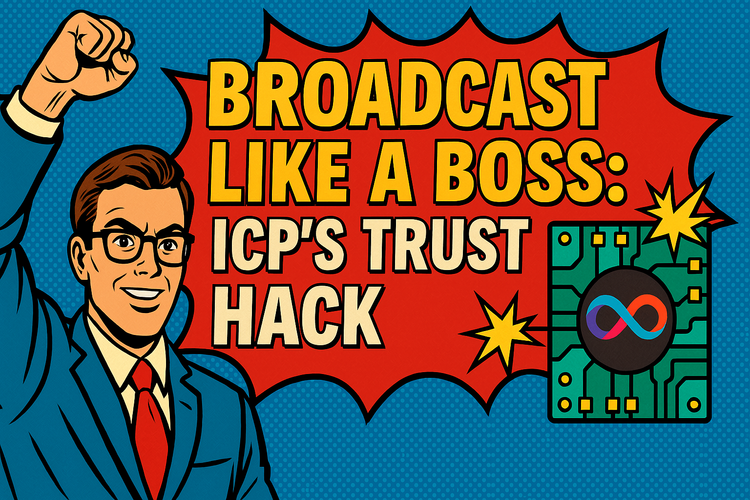How Secure Is Your Blockchain? Let's Dig In.

Cryptocurrencies were supposed to be unhackable, unstoppable, unbreakable... until they weren’t. A new survey paper by Zekai Liu and Xiaoqi Li just dropped the mic on blockchain vulnerabilities, categorizing 165 real-world attacks across five juicy layers of blockchain infrastructure.
Let's break it down... Here's every layer, every threat, every freaky flaw—and how ICP and other chains are (hopefully) ready to deal.
🔹 Layer 1: Data Layer Mayhem
🧡 Threats:
- Collision Attacks — Hash functions finding twinsies.
- Transaction Malleability — Same tx, different signature? Confusing!
⚡ How ICP Responds:
- Robust Hashing Strategy: While there's no official confirmation ICP uses BLAKE2b, the network's cryptographic stack is designed to resist hash collisions by using secure and modern hashing practices suitable for blockchain security. (More on BLAKE2b)
- Mitigation of Transaction Malleability: ICP avoids reliance on hash-ID-based broadcasting. Canisters validate full state transitions, and the transaction structure ensures identifiers reflect the complete signed content, making malleability a non-issue.
💬 Layer 2: Network Shenanigans
💥 Threats:
- Eclipse Attacks — Isolating a node to show it fake news.
- Defer Bombs — Spamming transactions to clog the mempool.
⚡ How ICP Responds:
- NNS-managed Subnets: Nodes are hand-picked and verified, not anyone-can-join.
- Ingress Rate Limiting: Request flooding? Nope. Requests are metered per user/per subnet.
🧵 Layer 3: Consensus Chaos
💣 Threats:
- Sybil Attacks — So many fake identities, like a Web3 catfish farm.
- 51% Attacks — Majority power means rewrite history!
⚡ How ICP Responds:
- Sybil Resistance = NNS Voting: Real-world identities stake ICP, making it expensive and trackable.
- No PoW: Since ICP doesn’t rely on raw hash power, there's no 51% attack vector like in Bitcoin. Consensus is done via threshold signatures + randomness beacon.
🔧 Layer 4: Contract Code Curses
🌋 Threats:
- Reentrancy — The "yo dawg, I called myself" attack.
- Integer Overflows — Whoops, your 0 just became a trillion.
- Resource Exhaustion — Gas-guzzlers draining the EVM.
⚡ How ICP Responds:
- Motoko + Rust + Type Safety: Safer programming languages vs Solidity.
- No Global Gas Model: Resources are prepaid and isolated per canister.
- Cycle-Based Execution: You pay to play, but not in gas units.
🚀 Layer 5: App Layer Antics
🌊 Threats:
- Selfish Mining — "I’ll keep my block, thx."
- Block Withholding — "I found a block. I’m not telling."
⚡ How ICP Responds:
- No Mining: Just certified node providers approved by the NNS.
- Reward System = Governance: Not mining for blocks but staking for votes. No incentive to hide blocks.
🌟 Bonus Round: What About Other Chains?
| Chain | Good Defense | Weakness |
|---|---|---|
| Ethereum | Smart contract maturity, large validator set | Still vulnerable to gas exhaustion, reentrancy unless coded well |
| Bitcoin | Super stable, battle-tested, very secure base layer | Slow evolution, PoW = Sybil + 51% risks |
| Solana | High throughput, optimistic future | Past outages, complex validator incentives |
| ICP | Full-stack app chain, deterministic, no miners | Less adoption, misunderstood tech |
✅ TL;DR:
- This paper is a must-read if you want to understand all the ways blockchains can break.
- ICP dodges many classic bullet holes thanks to its architecture.
- But no system is perfect. Ongoing vigilance = crypto’s survival plan.
Stay Notoko. Stay Secure. 🚀
💡 Subscribe to Notoko Bytes for more crypto chaos straight to your inbox! 🚀

Want to feature your brand on Notoko Bytes? 🚀 Contact us at ctrascend@gmail.com for sponsored posts!
Disclaimer
*The information and analysis provided in this article are intended for educational and informational purposes only and should not be considered as financial, investment, or professional advice. While our team strives to ensure the accuracy and reliability of the content, we make no representations or warranties of any kind, express or implied, about the completeness, accuracy, reliability, suitability, or availability of the information presented.
The content within this article may include opinions and forward-looking statements that involve risks and uncertainties. The blockchain and cryptocurrency markets are highly volatile, and past performance is not indicative of future results. Any reliance you place on the information presented is strictly at your own risk. Before making any investment decisions, we highly recommend consulting with a qualified financial advisor or conducting your own thorough research.
By accessing and using the information provided in this article, you acknowledge and agree that neither the authors, publishers, nor any other party involved in the creation or delivery of the content shall be held liable for any direct, indirect, incidental, consequential, or punitive damages, including but not limited to loss of profits, goodwill, or data, arising out of your use or inability to use the information provided or any actions you take based on the information contained within this section.*





